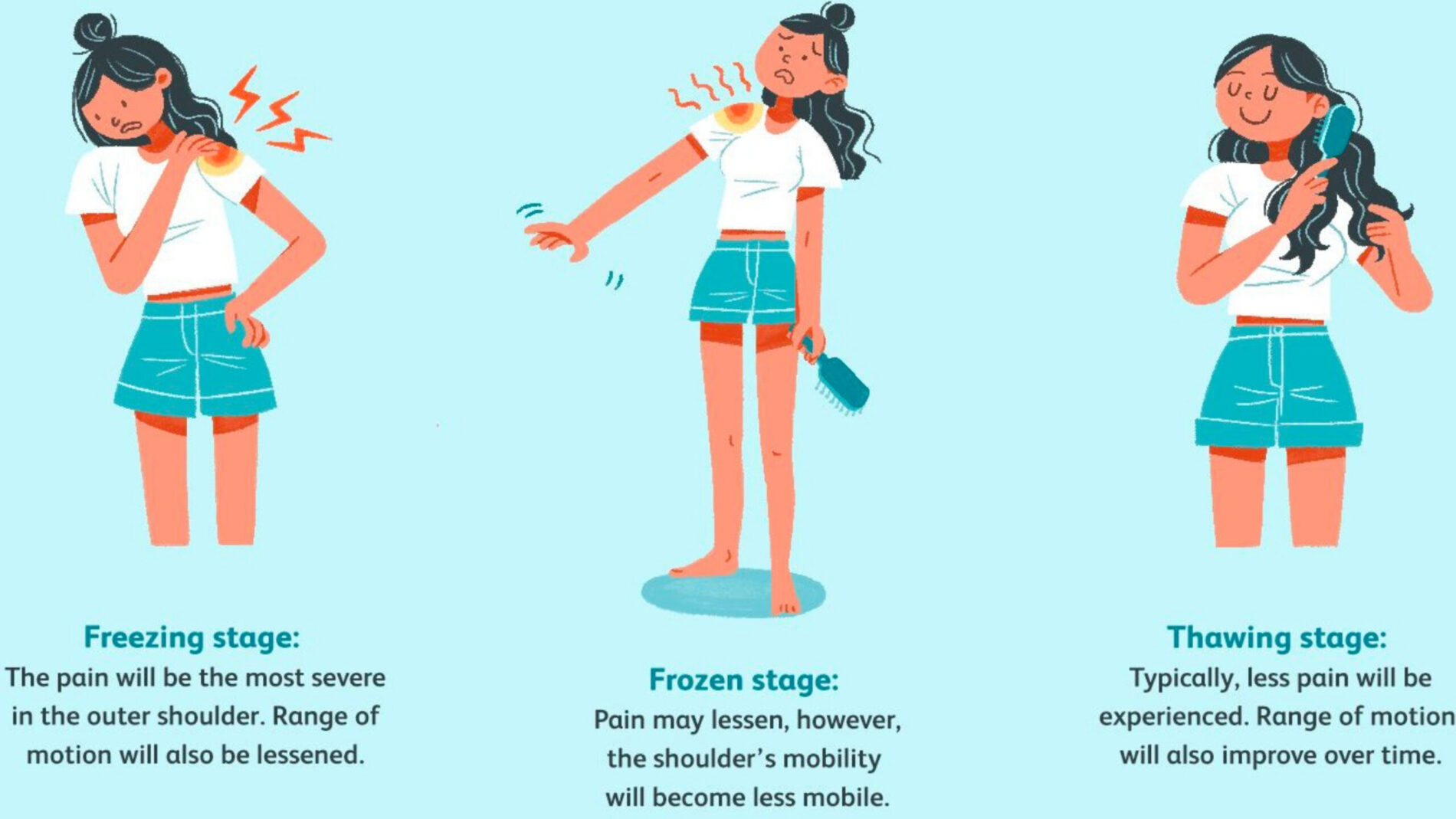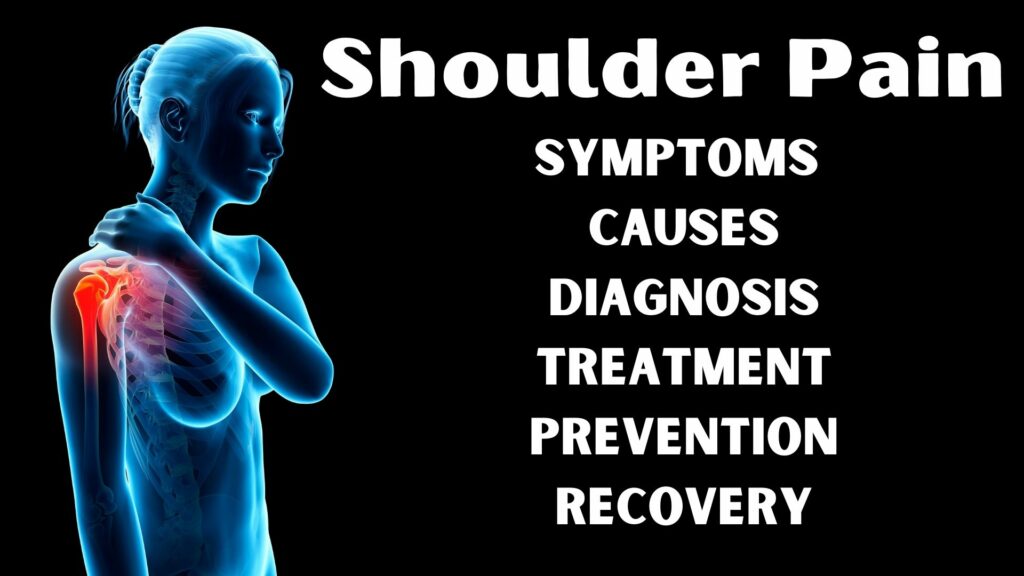Contents
Understanding Shoulder Pain

Frozen shoulder is a disease that affects the joints in your shoulder. It generally begins with shoulder pain and stiffness that gradually worsens until ultimately disappearing. It might take anything from a year to three years to complete. The ball-and-socket joint in your shoulder is made up of three bones. They are the humerus (upper arm), scapula (shoulder blade), and the collarbone (collarbone) (clavicle). Your shoulder joint is also surrounded by tissue that holds everything together. Furthermore, the shoulder capsule is what it’s called. The capsule thickens and tightens with a frozen shoulder, making it difficult to move. Scar tissue forms in the joint, and synovial fluid, which keeps the joint lubricated, is depleted. These items make it much more difficult to move around.
Moreover, adhesive capsulitis, commonly known as frozen shoulder, is a disease that causes stiffness and discomfort in the shoulder joint. Symptoms and signs normally appear gradually, intensify with time, and then disappear within one to three years. Suppose you’re recovering from a medical illness or surgery that stops you from moving your arms, such as a stroke. In that case, you’re more likely to develop a frozen shoulder.
Symptoms Of Shoulder Pain
The most common symptoms of a frozen shoulder are discomfort and stiffness, which make movement difficult or impossible.
You will most likely have a dull or achy discomfort in one shoulder if you have a frozen shoulder. The shoulder muscles that wrap across the top of your arm may also be in discomfort. It’s possible that you’re experiencing a similar sensation in your upper arm. It’s possible that your discomfort will worsen at night, making it difficult to sleep.
However, with a frozen shoulder, you’ll usually go through three stages. Each has its own set of symptoms as well as a timetable.

Freezing stage
- Each time you move your shoulder, you experience discomfort (sometimes severe).
- Over time, it is becoming worse and might ache more throughout the night.
- It can persist for six to nine months.
- How far you can move your shoulder is restricted to you.
Frozen Stage
- Your pain may improve, but your rigidity will grow worse.
- It gets tougher to move your shoulder and harder to do everyday tasks.
- This may take 4-12 months.
Thawing Stage
- Your movement begins to return to normal.
- It might take 6 months to 2 years to complete.
Causes Of Shoulder Pain
Some individuals may not know why, but some groups are more vulnerable to it. Frozen shoulder occurs most frequently among women than among males. Note that if you’re between 40 and 60, you might develop it more probable. If you are recuperating from a medical condition like a stroke or surgery like a mastectomy, which prevents your arm from moving, your risk may also increase. You may also raise your risk with certain medical problems. If you have diabetes, you may also have greater chances of frozen shoulder. Around 10% to 20% of diabetic patients have frozen shoulders. Frozen shoulder can also be related to other medical conditions such as heart disease, thyroid, or Parkinson’s disease.
In a bonding tissue, capsules have encircled the bones, ligaments, and skins forming your shoulders. When this capsule thickens and shrinks around the shoulder joint and restricts its movements, frozen shoulder develops.
Doctors don’t know why this is the case for certain people. Even though it is more common for those who have diabetes or have recently had to immobilize their shoulder for a lengthy time, as after surgery or an arm break.
Risk Factors
Some factors may enhance your chance of frozen shoulder development.
Sex and Age
The chances of individuals 40 years of age and older, in particular women, are higher. Although we cannot determine the category of people who may or may not develop the pain during their lifetime, all we can do is to take preventive measures to deal with the situation.
Immobility or Mobility Reduction
People with protracted immobility or decreased shoulder motion are at increased risk of frozen shoulder development. The outcome of several causes, including:
- Injury to the rotator mango
- Breached arm
- Operational Stroke Recovery
Systemic Illnesses
Persons with specific conditions tend to get frozen shoulder. Risk-enhancing diseases include:
- Diabetes
- Thyroid Overactive (hyperthyroidism)
- Thyroid underactive (hypothyroidism)
- Cardiovascular illness
- Tuberculosis
- Disease of Parkinson
Diagnosis of Shoulder Pain
Your doctor will do a physical exam to diagnose the frozen shoulder. You will see how awful and how far it goes. You’re going to check. They will let you move your shoulder themselves during the “active” phase of the test. They’ll move it for you during the “passive” section and notice the changes.
It is possible that your doctor decides that you require the injection of anesthesia. This is a medicine that engulfs the discomfort to better evaluate your active and passive movement ranges.
Furthermore, a doctor can typically conduct imaging tests such as radiation, ultrasounds, or MRIs. This will help to avoid other issues such as arthritis or ripping a rotator cuff. It may also cause discomfort and restrict the amount of time it goes. A frozen shoulder can be diagnosed with a medical examination.
Treatment of Shoulder Pain

Non-inflammatory over-the-counter (NSAIDs) medicines such as aspirin or ibuprofen can help alleviate shoulder discomfort and inflammation. Your doctor may prescribe a stronger medicine if they don’t help.
The therapy could also include visiting a physical therapist for strengthening and stretching exercises to enhance your range of motion.
Your doctor can prescribe different therapy types if your symptoms are strong or do not improve with time, including:
- Injection of corticosteroids into your shoulder joint to lower your discomfort and increase your movement.
- Joint distension: This implies that your doctor injects sterile water into your shoulder. This might make it easier to move your shoulder.
- Physical Therapy: The results are varied, and at some periods of a frozen shoulder, it may be more beneficial than others.
- Surgery: It is rare that doctors recommend surgery for frozen shoulder treatment. Your doctor may advise surgery, though, if other therapies have not worked. It would probably be surgery for arthroscopy. However, this is done with lightweight instruments of pencil dimensions that are introduced into your shoulder through little incisions.
- Manipulation of the shoulders can assist release your shoulder tissue, but it is relatively unusual because arthroscopic operation replaced it. Also. the surgeons would move their shoulders aggressively under general anesthesia. The risk of consequences including fractures raises during this procedure.
Prevention Of Shoulder Pain
One of the most prevalent reasons for a frozen shoulder is the absence of any shoulder injury. Other reasons are broken arm or stroke during rehabilitation. Moreover, if your shoulder has been injured, talk to your doctor about exercises. You may take to keep your shoulder joint mobility range. Here are a few preventive measures that you can take to prevent shoulder pain:
Listen to your body. Listen to your body. Don’t ignore it if your shoulder is painful following any activity. See your doctor if the pain is severe and it does not go away. It doesn’t have to be tough. You may simply worsen things.
Stay in form. Maintain your body with regular exercise and nutritious nutrition in a good physique. It’s a good method to stay and to avoid damage.
Train in the proper direction. Warm-up before you’re exercising. Start cautiously if a sport or activity hasn’t been done for a time now. Learn how weights can be lifted correctly. Don’t raise too much.
Watch out at work. Make sure your work shoulder is not injured.
- When sitting or standing, use a healthy posture.
- Follow the lifting rules. Stay straight back and utilize the legs.
- Every hour take a rest for a few minutes. Move and stretch. Move about.
- Make sure your workstation is set up to allow you to use your computer comfortably. It will help you if you work at a desk.
- Although, if you have to access high locations, use a step stool. In drawers or lower shelves, put the goods you are using.
How can I Recover?
These items should assist you to feel better if you injured your shoulder:
- Rest and ice are the most important thing. Every couple of hours, use ice.
- Ask your doctor whether you can treat pain medications like aspirin, ibuprofen, or naproxen on an ongoing basis.
- Make sure you do it if your doctor recommends physical therapy.
- In the end, do not wear a sling. Do not wear a sling. You want your arm to move freely. Don’t overdo it.
A Word From Mantra Care
We know that people who suffer from shoulder pain often feel like they can’t do much of anything. The good news is, there are steps you can take to reduce or even eliminate your shoulder pain—and we have the resources to help! Whether it’s a one-time fix for temporary relief or something more long-term, our team at Austin Pain Doctors has what you need. Let us show you how we’ve helped so many others find relief with nonsurgical solutions and rehabilitation programs designed just for them. You can also check one of our famous subsidiary PhysioMantra for online physiotherapy, Shoulder Pain treatment and more.
Physical Therapy help patients recover from pain. If you’re experiencing Back pain, Shoulder pain, Knee pain, Neck pain, Elbow pain, Hip pain or Arthritis pain, physical therapist at MantraCare can help: Book a physio therapy session.


